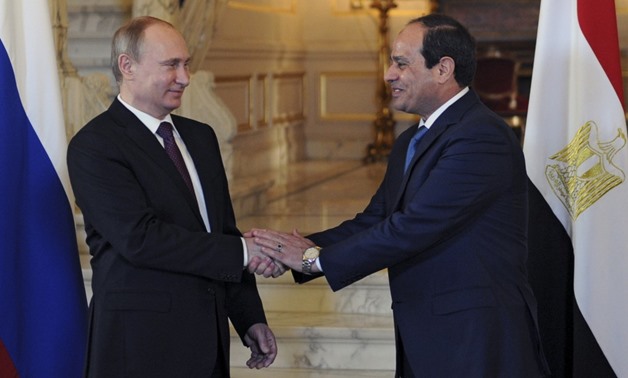
Egyptian President Abdel Fatah al-Sisi and his Russian counterpart Vladimir Putin – Press photo
CAIRO – 17 December 2017: Several reports about the resumption of direct flights between Egypt and Russia in February were circulated in the media, making Egyptians heave a sigh of relief after 26 months of air traffic suspension.
During that period, the Egyptian government spared no effort to find a solution to the issue, raising questions on the importance of this anticipated step to Egypt.
In October 2015, the Airbus A321, operated by Metrojet, crashed over the Sinai Peninsula, which was carrying Russian tourists returning from the Red Sea resort of Sharm El-Sheikh to St. Petersburg, killing all 224 on board.
Although Egypt-Russia investigations have yet to reveal the reason of the crash, Russia, along with some other countries, decided to suspend direct flights to Cairo and Sharm El-Sheikh for indefinite period. The decision decimated Egypt's vital tourism industry.
The tourism sector is one of Egypt’s main foreign currency earners, which has suffered badly from the travel ban that turned the once 100 percent occupied resorts to empty places.
To understand the impact of a possible resumption of air links, one should know that Egypt is highly regarded as a tourist destination that can attract diverse types of tourists, such as those interested in exploring the country’s ancient culture, or those who want to enjoy sunny beaches.
Tourist inflow to Egypt peaked in 2010, when 14.7 million tourists visited the country, but the number fell to 4.5 million in 2016.
Russian and British tourists capture the largest portion of tourist inflows to Egypt. According to the Central Agency for Public Mobilization and Statistics (CAPMAS), the Russian tourist inflow to Egypt reached its peak in 2014, with tourists recording 3.1 million. Following the Russian plane crash, this number went down to 2.38 million in 2015.
The British tourist inflow used to range between 800,000 to one million tourists, but this number also declined after the suspension of flights to Sharm El-Sheikh. British flights are now limited to the tourist areas in the Red Sea and the Upper Egyptian cities of Luxor and Aswan.
Despite this, there are indicators that suggest that tourism will bounce back, with the Ministry of Tourism announcing that tourist numbers are estimated to reach eight million by the end of 2017, compared to 4.5 million tourists last year. How this can be possible?
The capacity of South Sinai’s hotels, including Sharm El-Sheikh, represent 35 percent of the total hotel capacity in Egypt, estimated at 225,000 rooms, of which about 65,000 rooms are in the Red Sea, 30,000 in Greater Cairo, and the rest in other provinces.
It means that the majority of Egypt’s hotel capacity lies outside the banned region. However, South Sinai represents 40-45 percent of Egyptian annual tourism income, and it can add $12 billion annually.
Meanwhile, the ministry said in a previous statement that a noticeable influx of Asian tourists started flocking to Cairo, Luxor and Aswan. The Asian visitors have mitigated the negative effects of the absence of Russian and British tourists.
China’s top public travel agency, China International Travel Service, reported a 58 percent increase in tourists flying to Egypt in 2016 compared to 2015, while Japan’s HIS travel agency said the number of tourists heading to Egypt was multiplied by four to five times last year.
The boom in Asian interest may be a result of the World Tourism Organization's decision to name Luxor the world’s tourism capital of 2016.
According to CAPMAS, the number of tourists who visited Egypt in fiscal year 2016/17 rose by 259,700 tourists to 732,700 tourists.
Additionally, tourist nights stood at almost 9.6 million nights in September 2017, versus three million in September 2016.
Number of tourists recorded a 32.9 percent year-on-year surge in May 2017, according to CAPMAS.
The return of Russian flights would boost tourist numbers, but it should be noted that the industry is already recovering gradually.

Comments
Leave a Comment